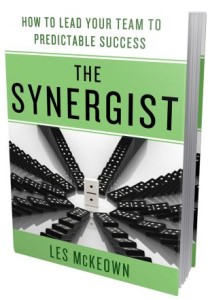 The Unstable Triangle: Part 1 of 5 in a series on the book The Synergist: How to Lead Your Team to Predictable Success by Les McKeown
The Unstable Triangle: Part 1 of 5 in a series on the book The Synergist: How to Lead Your Team to Predictable Success by Les McKeown
(Business Book Review – The Synergist Click here to read the Intro)
Are you working in a partnership or in a company where you find that it is rich in talent with a mind-blowing product or maybe a “have to have” service? There is energy everywhere. I imagine there is a beautiful office with phenomenal employees and it appears as if the company will soar to the top, a legend in it’s own time. In reality, you know there is something amiss and, as the business pushes on, you watch it slowly disintegrate (or worse yet, you wake up and its gone). Is it your company? Are you working for a One Hit Wonder? Maybe it isn’t even a company, maybe it’s a sports team or an association. Were you hired into a place like this? If someone gave you the inside track on this company’s path, would you bet on them or would you chose another road? How many years do you lose of your life not knowing what others might find incredibly obvious. This is why I am compelled to write about this book, to offer what may save some valuable years in ones business life. I am going to briefly explain the components of the team that McKeown describes so vividly. (We will go in depth about each role in subsequent blogs) In the end, we will put all of the players together and analyze their patterns.
There are four major roles that McKeown explores in The Synergist. Each one brings positive aspects to their role and their necessity to the company. Without any one of these roles, the company would not have the same visibility, functionality or longevity. With each one comes a series of characteristics that also impede processes, create tension and stunt the growth of the team. As we explore these roles, think about yourself and those around you. Think about how you are affected by each of these “personalities” and how you affect others. That is the key to this insightful information. That you can be a proponent of change for the good just by understanding the dynamics of these roles.
The Visionary (V): First of all, it always strikes me in an odd way that so many people that I meet who are creative, engaging, innovative and have a bit of an ego loudly declare themselves visionaries. They clearly have an aura of confidence and a vision for taking something to the top. That does not mean that they need to invent the idea, moreover they feel they can take an idea to the top with flawless execution. Most of them truly are a visionary and, as I’ve found out, there is always a degree to which they are a visionary. In the Synergist, McKeown believes that you can be a percentage of visionary by nature, but lesser percentage of another role. Visionaries tend to have a passion to make a difference, recognize amazing ideas and can rally a team behind them. They can also flit from one idea to the next, run people ragged by not following through and have to put some of themselves on everyone else’s work to make it their own. Recognize this person?
The Operator (O): Once the Visionary starts rallying, they need to find the go to person: The Operator. While the the Visionary is rallying with the big picture, the Operator is the go to person as they that can go out and get things done. An Operator tends to work ungodly hours to follow through on the “vision”. An Operator may not get the spotlight but they are critical nonetheless. They make things happen using whatever means they can find. Operators move independently, prefer being out and about rather than in a meeting or an office and do not adapt easily to extensive policies as that holds them back. Once involved in a project, they do best with little management or strings attached. As a company grows and more complex policies emerge, an Operator tends to lose patience with the barriers and blockades and lose steam as they lose autonomy. I often wonder if business owners that have a small but manageable staff tend to be Operators. I also wonder if there is a direct correlation to a specific birth order position.
Last in the triangle is the Processor (P): I can tell you from experience that a business that lacks a Processor (or processes for that matter) cannot create a grander scale and take that vision to the top. You must be asking yourself “If the Processor creates and institutes processes, structure and discipline, isn’t that counterintuitive to the Operator and a buzzkill for the Visionary? BINGO. That is where instability arises. The Processor is brought in to bring order to the company, but the better they are at their natural tendencies, the more friction and tension the company experiences.
What to do? Understanding each role better, including the strengths and weaknesses of each role, can be monumental. There is another role call the Synergist that plays out as the mediator (someone who can actually get these three to listen and be present in one meeting) bringing cooperation amongst the players. More blogs to come on each of these profiles. I’d love to hear more about your experiences with a V an O and a P!

